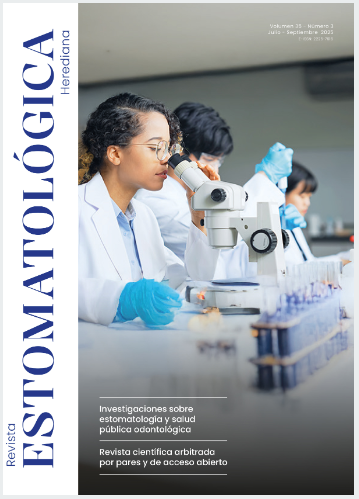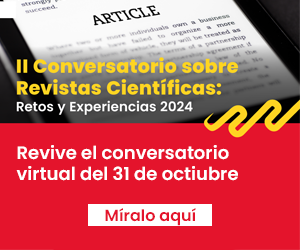Dispositivos de avance mandibular como tratamiento para la apnea obstructiva del sueño: una revisión de la literatura
DOI:
https://doi.org/10.20453/reh.v35i3.5989Palabras clave:
apnea de sueño, apnea obstructiva del sueño, apnea, dispositivo de avance mandibularResumen
La apnea obstructiva del sueño (AOS) es un trastorno del sueño resultante del estrechamiento y el colapso del tracto respiratorio superior. Se la ha vinculado con un mayor riesgo de accidentes vehiculares, desarrollo de diabetes y enfermedades cardiovasculares, lo que la convierte en un problema relevante de salud pública. En los últimos años, se han popularizado los dispositivos intraorales de avance mandibular como una opción para el tratamiento del ronquido y de la AOS. Estos dispositivos son bien tolerados por la mayoría de los pacientes, y su eficacia terapéutica ha sido ampliamente comprobada. En este escenario, es importante conocer cuáles son las ventajas de su uso, el protocolo de tratamiento y sus posibles efectos secundarios.
Descargas
Citas
Heinzer R, Marti-Soler H, Haba-Rubio J. Prevalence of sleep apnoea syndrome in the middle to old age general population. Lancet Respir Med [Internet]. 2016; 4(2): e5-e6. Disponible en: https://dx.doi.org/ 10.1016/S2213-2600(16)00006-0
Bartolucci ML, Bortolotti F, Corazza G, Incerti S, Paganelli C, Alessandri G. Effectiveness of different mandibular advancement device designs in obstructive sleep apnoea therapy: a systematic review of randomised controlled trials with meta-analysis. J Oral Rehabil [Internet]. 2021; 48(4): 469-486. Disponible en: https://doi.org/10.1111/joor.13077
Wojda M, Jurkowski P, Lewandowska A, Mierzwińska-Nastalska E, Kostrzewa-Janicka J. Mandibular advancement devices in patients with symptoms of obstructive sleep apnea: a review [Internet]. En: Pokorski M, editor. Medical Science and Research. Advances in Experimental Medicine and Biology. Cham: Springer; 2019. pp. 11-17. Disponible en: https://doi.org/10.1007/5584_2019_334
Douglas NJ, Polo O. Pathogenesis of obstructive sleep apnoea/hypopnoea syndrome. Lancet [Internet]. 1994; 344(8923): 653-655. Disponible en: https://doi.org/10.1016/s0140-6736(94)92088-5
Francis CE, Quinnell T. Mandibular advancement devices for OSA: an alternative to CPAP? Pulm Ther [Internet]. 2021; 7(1): 25-36. Disponible en: https://doi.org/10.1007/s41030-020-00137-2
Hudgel DW. Mechanisms of obstructive sleep apnea. CHEST [Internet]. 1992; 101(2): 541-549. Disponible en: https://doi.org/10.1378/chest.101.2.541
Sharples LD, Clutterbuck-James AL, Glover MJ, Bennett MS, Chadwick R, Pittman MA, et al. Meta-analysis of randomised controlled trials of oral mandibular advancement devices and continuous positive airway pressure for obstructive sleep apnoea-hypopnoea. Sleep Med Rev [Internet]. 2016; 27: 108-124. Disponible en: https://doi.org/10.1016/j.smrv.2015.05.003
Olivi H. Apnea del sueño: cuadro clínico y estudio diagnóstico. Rev Méd Clín Las Condes [Internet]. 2013; 24(3): 359-373. Disponible en: https://doi.org/10.1016/S0716-8640(13)70173-1
Lloberes P, Durán-Cantolla J, Martínez-García MÁ, Marín JM, Ferrer A, Corral J, et al. Diagnóstico y tratamiento del síndrome de apneas-hipopneas del sueño. Arch Bronconeumol [Internet]. 2011; 47(3): 143-156. Disponible en: https://doi.org/10.1016/j.arbres.2011.01.001
Sleep-related breathing disorders in adults: recommendations for syndrome definition and measurement techniques in clinical research. Sleep [Internet]. 1999; 22(5): 667-689. Disponible en: https://doi.org/10.1093/sleep/22.5.667
Practice parameters for the treatment of snoring and obstructive sleep apnea with oral appliances. Sleep [Internet]. 1995; 18(6): 511-513. Disponible en: https://doi.org/10.1093/sleep/18.6.511
Simonds AK. New developments in the treatment of obstructive sleep apnoea. Thorax [Internet]. 2000; 55(suppl 1): S45-S50. Disponible en: https://doi.org/10.1136/thorax.55.suppl_1.s45
Monasterio C, Navarro A, Brinquis T, Estopà R, Manresa F, Farreras S, et al.. Eficacia de una prótesis de avance mandibular en el tratamiento del síndrome de apneas obstructivas del sueño. Arch Bronconeumol [Internet]. 2000; 36(7): 371-376. Disponible en: https://doi.org/10.1016/S0300-2896(15)30136-8
Ramar K, Dort LC, Katz SG, Lettieri CJ, Harrod CG, Thomas SM, et al. Clinical practice guideline for the treatment of obstructive sleep apnea and snoring with oral appliance therapy: an update for 2015. J Clin Sleep Med [Internet]. 2015; 11(7): 773-827. Disponible en: https://doi.org/10.5664/jcsm.4858
Pitsis AJ, Darendeliler MA, Gotsopoulos H, Petocz P, Cistulli PA. Effect of vertical dimension on efficacy of oral appliance therapy in obstructive sleep apnea. Am J Respir Crit Care Med [Internet]. 2002; 166(6): 860-864. Disponible en: https://doi.org/10.1164/rccm.200204-342OC
Sakamoto Y, Furuhashi A, Komori E, Ishiyama H, Hasebe D, Sato K, et al. The most effective amount of forward movement for oral appliances for obstructive sleep apnea: a systematic review. Int J Environ Res Public Health [Internet]. 2019; 16(18): 3248. Disponible en: https://doi.org/10.3390/ijerph16183248
Ghazal A, Sorichter S, Jonas I, Rose EC. A randomized prospective long-term study of two oral appliances for sleep apnoea treatment. J Sleep Res [Internet]. 2009; 18(3): 321-328. Disponible en: https://doi.org/10.1111/j.1365-2869.2009.00738.x
Bloch KE, Iseli A, Zhang JN, Xie X, Kaplan V, Stoeckli PW, et al. A randomized, controlled crossover trial of two oral appliances for sleep apnea treatment. Am J Respir Crit Care Med [Internet]. 2000; 162(1): 246-251. Disponible en: https://doi.org/10.1164/ajrccm.162.1.9908112
Durán-Cantolla J, Crovetto-Martínez R, Alkhraisat MH, Crovetto M, Municio A, Kutz R, et al. Efficacy of mandibular advancement device in the treatment of obstructive sleep apnea syndrome: a randomized controlled crossover clinical trial. Med Oral Patol Oral Cir Bucal [Internet]. 2015; 20(5): e605-e615. Disponible en: http://doi.org/doi:10.4317/medoral.20649
Addy N, Bennett K, Blanton A, Dort L, Levine M, Postol K, et al. Policy statement on a dentist’s role in treating sleep-related breathing disorders. J Dent Sleep Med [Internet]. 2018; 5(1): 25-26. Disponible en: http://dx.doi.org/10.15331/jdsm.6920
Descargas
Publicado
Cómo citar
Número
Sección
Licencia
Derechos de autor 2025 Gina Maritza Laquihuanaco Coarita, Lidia Yileng Tay Chu Jon

Esta obra está bajo una licencia internacional Creative Commons Atribución 4.0.
Los autores conservan los derechos de autor y ceden a la revista el derecho de primera publicación, con el trabajo registrado con la Licencia de Creative Commons, que permite a terceros utilizar lo publicado siempre que mencionen la autoría del trabajo, y a la primera publicación en esta revista.























